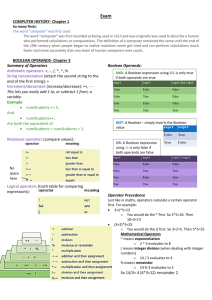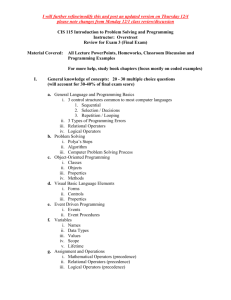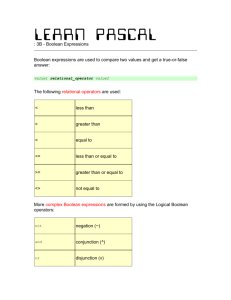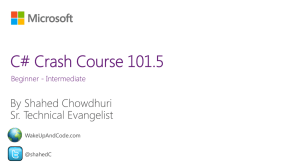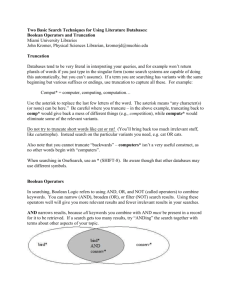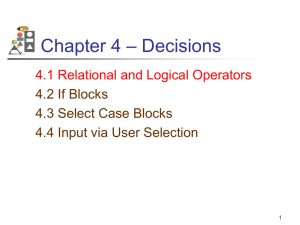Chapter 4
advertisement
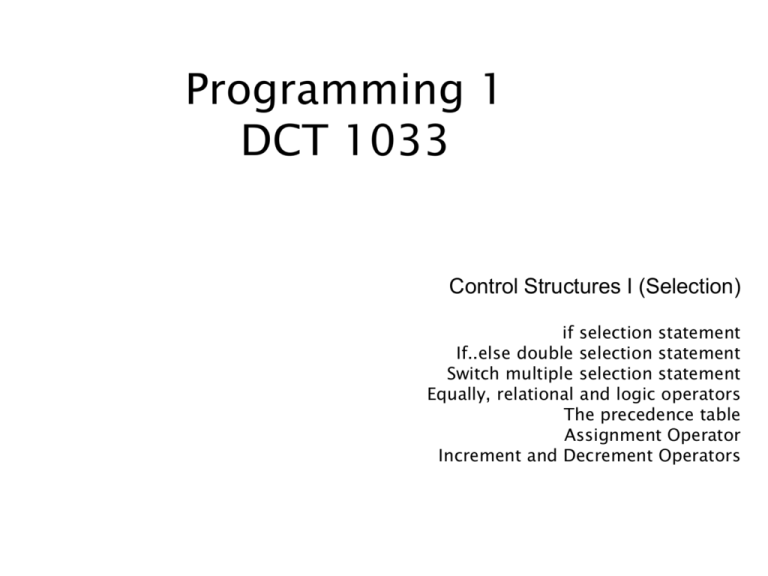
Programming 1
DCT 1033
Control Structures I (Selection)
if selection statement
If..else double selection statement
Switch multiple selection statement
Equally, relational and logic operators
The precedence table
Assignment Operator
Increment and Decrement Operators
Objectives
In this chapter, you will:
• Learn about control structures
• Examine relational and logical operators
• Explore how to form and evaluate logical (Boolean)
expressions
• Discover how to use the selection control structures
if, if...else, and switch in a program
• Learn how to avoid bugs by avoiding partially
understood concepts and techniques
2
Control Structures
• A computer can proceed:
– In sequence
– Selectively (branch) - making a choice
– Repetitively (iteratively) - looping
• Some statements are executed only if certain
conditions are met
• A condition is met if it evaluates to true
3
Control Structures (continued)
4
Relational Operators
• A condition is represented by a logical (Boolean)
expression that can be true or false
• Relational operators:
– Allow comparisons
– Require two operands (binary)
– Evaluate to true or false
5
Relational Operators (continued)
6
Relational Operators and Simple Data
Types
• You can use the relational operators with all three
simple data types
–
–
–
–
8 < 15 evaluates to true
6 != 6 evaluates to false
2.5 > 5.8 evaluates to false
5.9 <= 7.5 evaluates to true
7
Comparing Characters
8
Relational Operators and the
string Type
• Relational operators can be applied to strings
• Strings are compared character by character,
starting with the first character
• Comparison continues until either a mismatch is
found or all characters are found equal
• If two strings of different lengths are compared and
the comparison is equal to the last character of the
shorter string:
– The shorter string is less than the larger string
9
Relational Operators and the
string Type (continued)
• Suppose we have the following declarations:
string
string
string
string
string
str1
str2
str3
str4
str4
=
=
=
=
=
"Hello";
"Hi";
"Air";
"Bill";
"Big";
10
Relational Operators and the
string Type (continued)
11
Relational Operators and the
string Type (continued)
12
Relational Operators and the
string Type (continued)
13
Logical (Boolean) Operators and
Logical Expressions
• Logical (Boolean) operators enable you to combine
logical expressions
unary
binary
binary
14
Logical (Boolean) Operators and
Logical Expressions (continued)
15
16
17
Order of Precedence
• Relational and logical operators are evaluated from
left to right
• The associativity is left to right
• Parentheses can override precedence
18
Order of Precedence (continued)
19
Order of Precedence (continued)
20
21
Order of Precedence (continued)
22
The bool Data Type and Logical
(Boolean) Expressions
• The data type bool has logical (Boolean) values
true and false
• bool, true, and false are reserved words
23
Formatting Logical (Boolean)
Expressions: A Precaution
• Logical expressions can be unpredictable
• The following expression appears to represent a
comparison of 0, num, and 10:
0 <= num <= 10
• It always evaluates to true because 0 <= num
evaluates to either 0 or 1, 0 <= 10 is true, and 1
<= 10 is true
• A correct way to write this expression is:
0 <= num && num <= 10
24
Selection: if and if...else
•
•
•
•
•
One-way selection
Two-way selection
Compound (block of) statements
Multiple selections: nested if
Comparing if...else statements with a series of
if statements
25
One-Way Selection
• The syntax of one-way selection is:
• The statement is executed if the value of the
expression is true
• The statement is bypassed if the value is false;
program goes to the next statement
• if is a reserved word
26
One-Way Selection (continued)
27
One-Way Selection (continued)
28
29
One-Way Selection (continued)
30
Two-Way Selection
• Two-way selection takes the form:
• If expression is true, statement1 is executed;
otherwise, statement2 is executed
– statement1 and statement2 are any C++
statements
• else is a reserved word
31
Two-Way Selection (continued)
32
Two-Way Selection (continued)
33
Two-Way Selection (continued)
34
Compound (Block of) Statement
• Compound statement (block of statements)
• A compound statement is a single statement
35
Compound (Block of) Statement
(continued)
if (age >
{
cout <<
cout <<
}
else
{
cout <<
cout <<
}
18)
"Eligible to vote." << endl;
"No longer a minor." << endl;
"Not eligible to vote." << endl;
"Still a minor." << endl;
36
Multiple Selections: Nested if
• Nesting: one control statement in another
• An else is associated with the most recent if that
has not been paired with an else
37
38
Multiple Selections: Nested if
(continued)
39
Comparing if…else Statements with
a Series of if Statements
40
Confusion Between == and =
• C++ allows you to use any expression that can be
evaluated to either true or false as an
expression in the if statement:
if (x = 5)
cout << "The value is five." << endl;
• The appearance of = in place of == resembles a
silent killer
– It is not a syntax error
– It is a logical error
41
switch Structures
• switch structure: alternate to
if-else
• switch (integral) expression is
evaluated first
• Value of the expression
determines which
corresponding action is taken
• Expression is sometimes called
the selector
42
43
switch Structures (continued)
• One or more statements may follow a case label
• Braces are not needed to turn multiple statements
into a single compound statement
• The break statement may or may not appear after
each statement
• switch, case, break, and default are reserved
words
– Use of default is not required, but recommended
44
45
Summary
• Control structures alter normal control flow
• Most common control structures are selection and
repetition
• Relational operators: ==, <, <=, >, >=, !=
• Logical expressions evaluate to 1 (true) or 0
(false)
• Logical operators: ! (not), && (and), || (or)
• Three selection structures: one-way selection, twoway selection, and switch statement
46
Summary (continued)
• The expression in an if or if...else structure is
usually a logical expression
• No stand-alone else statement in C++
– Every else has a related if
• A sequence of statements enclosed between { and
} is a compound statement or block of statements
• switch structure handles multiway selection
• break statement ends switch statement
47
